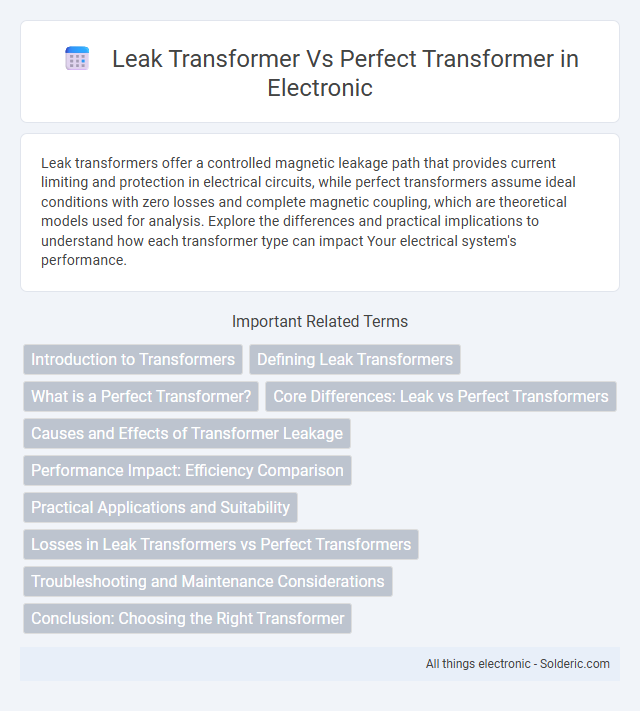Leak transformers offer a controlled magnetic leakage path that provides current limiting and protection in electrical circuits, while perfect transformers assume ideal conditions with zero losses and complete magnetic coupling, which are theoretical models used for analysis. Explore the differences and practical implications to understand how each transformer type can impact Your electrical system's performance.
Comparison Table
| Feature | Leak Transformer | Perfect Transformer |
|---|---|---|
| Definition | Transformer variant with controlled information leakage for improved generalization. | Ideal Transformer with flawless attention and no information loss. |
| Attention Mechanism | Leaky attention allowing partial information flow. | Exact attention with complete information retention. |
| Computational Complexity | Lower complexity due to approximations. | Higher complexity demanding full computations. |
| Performance | Balances efficiency and accuracy. | Optimal accuracy with maximum resource usage. |
| Use Cases | Resource-constrained environments and faster inference. | Research and applications requiring highest precision. |
| Information Flow | Controlled leakage for regularization. | Perfect, lossless data propagation. |
Introduction to Transformers
Transformers, essential components in electrical systems, convert voltage levels while maintaining power flow between circuits. A perfect transformer operates under ideal conditions with no energy loss, ensuring 100% efficiency and purely reactive behavior. In contrast, a leakage transformer accounts for real-world imperfections such as leakage reactance and winding resistance, causing slight energy losses and reduced efficiency.
Defining Leak Transformers
Leak transformers are a type of electrical transformer characterized by intentional magnetic flux leakage to improve performance in applications such as ballasts and lighting. Unlike perfect transformers, which assume ideal magnetic coupling with no flux loss, leak transformers utilize controlled leakage inductance to regulate current and protect connected devices. This deliberate design distinction enhances operational reliability and efficiency in specific electrical circuits.
What is a Perfect Transformer?
A perfect transformer is an idealized electrical device with no energy losses, meaning zero resistance, zero leakage inductance, and perfect magnetic coupling between the primary and secondary windings. It transfers electrical power with 100% efficiency, ensuring the input voltage and current are transformed according to the turns ratio without any drops or distortions. In contrast, practical transformers exhibit leakage inductance and resistive losses, which cause deviations from this ideal behavior.
Core Differences: Leak vs Perfect Transformers
Leak transformers exhibit controlled magnetic flux leakage, causing energy loss and reduced efficiency, while perfect transformers assume ideal magnetic coupling with no flux leakage, ensuring 100% energy transfer between primary and secondary coils. The core difference lies in the magnetic circuit design: leak transformers have intentional gaps or less efficient core materials to manage voltage regulation and current limiting, whereas perfect transformers rely on an ideal core with infinite permeability for optimal performance. Understanding these distinctions is critical for applications like voltage stabilization, where leak transformers offer practical benefits despite lower efficiency compared to perfect transformers.
Causes and Effects of Transformer Leakage
Transformer leakage occurs due to imperfect magnetic coupling between the primary and secondary windings, causing energy losses and reduced efficiency. Leakage inductance results in voltage drops, increased heat generation, and potential interference with your system's voltage regulation. Minimizing transformer leakage enhances performance by ensuring better energy transfer and maintaining voltage stability under varying load conditions.
Performance Impact: Efficiency Comparison
Leak transformers exhibit higher energy losses and lower efficiency compared to perfect transformers due to leakage inductance causing voltage drops and heat generation. Perfect transformers theoretically achieve near 100% efficiency by assuming no leakage flux and zero winding resistance, ensuring maximum energy transfer between primary and secondary coils. In practical applications, minimizing leakage and optimizing magnetic coupling are essential to approach the ideal performance of a perfect transformer.
Practical Applications and Suitability
Leak transformers are ideal for applications requiring controlled voltage regulation and smooth load switching, commonly found in lighting systems and industrial controls where energy efficiency is critical. Perfect transformers, with near-ideal efficiency and minimal losses, suit precision electronic devices and power distribution systems demanding stable voltage output and minimal ripple. Choosing between the two depends on the need for energy efficiency, voltage stability, and the specific load characteristics in practical scenarios.
Losses in Leak Transformers vs Perfect Transformers
Leak transformers exhibit higher losses compared to perfect transformers due to inherent leakage inductance and stray magnetic flux, which dissipate energy as heat and reduce efficiency. Perfect transformers, idealized with zero leakage inductance and no core losses, maintain maximum energy transfer with negligible losses. The discrepancy in leakage inductance primarily drives increased copper and core losses in leak transformers, impacting voltage regulation and overall performance.
Troubleshooting and Maintenance Considerations
Leak transformers often demand more frequent inspections due to their susceptibility to insulation degradation and core losses, which can cause overheating and reduced efficiency. Perfect transformers, characterized by ideal components and negligible losses, simplify troubleshooting by minimizing issues related to winding resistance and magnetic leakage. Maintenance for leak transformers involves careful monitoring of oil levels, cooling systems, and insulation integrity, whereas perfect transformers require less intensive upkeep, focusing mainly on connections and external components.
Conclusion: Choosing the Right Transformer
Choosing the right transformer depends on the application's voltage regulation and efficiency requirements; perfect transformers model ideal conditions with no losses, while leak transformers realistically account for voltage drops and energy dissipation through leakage inductance and resistance. For precision tasks and simulations, perfect transformers simplify calculations by assuming 100% efficiency, whereas leak transformers provide practical insights into performance under load and help in designing protective measures. Proper selection balances accuracy needs, operational conditions, and system complexity to ensure reliability and optimal functionality.
leak transformer vs perfect transformer Infographic

 solderic.com
solderic.com